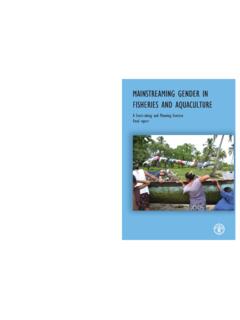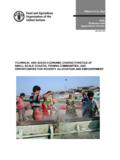Transcription of Report of the Committee on Doubling Farmers’ …
1 Ministry of Agriculture & farmers Welfare Report of the Committee on Doubling farmers income Volume XI Empowering the farmers through Extension and Knowledge Dissemination Agricultural Extension & Knowledge Diffusion, Skill and ICT: Empower every Farmer in every Corner Document prepared by the Committee on Doubling farmers income , Department of Agriculture, Cooperation and farmers Welfare, Ministry of Agriculture & farmers Welfare. November 2017 Doubling farmers income Volume XI Empowering the farmers through Extension i Foreword The country has witnessed a series of concerted discussions dealing with the subject of agriculture.
2 In 1926, the Royal Commission of Agriculture was set up to examine and Report the status of India s agricultural and rural economy. The Commission made comprehensive recommendations, in its Report submitted in 1928, for the improvement of agrarian economy as the basis for the welfare and prosperity of India s rural population. The urban population was about 11 per cent of the whole, and demand from towns was small in comparison. The Commission notes, that communication and physical connectivity were sparse and most villages functioned as self-contained units.
3 The Commission encompassed review of agriculture in areas which are now part of Pakistan, Bangladesh and Myanmar. The net sown area in erstwhile British India was reported as million hectares and cattle including buffaloes numbered 151 million. Almost 75 per cent of the cultivated area was under cereals and pulses, with rice and wheat occupying 46 per cent of the net sown area. The area under fruits and vegetables was about per cent and that under oilseeds and non-food crops was about 20 per cent. In the ensuing years, as well known, the country underwent vast changes in its political, economic and social spheres.
4 Almost 40 years later, free India appointed the National Commission on Agriculture in 1970, to review the progress of agriculture in the country and make recommendations for its improvement and modernisation. This Commission released its final Report in 1976. It refers to agriculture as a comprehensive term, which includes crop production together with land and water management, animal husbandry, fishery and forestry. Agriculture, in 1970 provided employment to nearly 70 per cent of the working population.
5 The role of agriculture in the country s economic development and the principle of growth with social justice, were core to the discussions. The country was then facing a high population growth rate. After impressive increase in agricultural production in the first two Five Year Plans, a period of stagnancy set in and the country suffered a food crisis in the mid-1960s. The Report in fifteen parts, suggested ample focus on increased application of science and technology to enhance production. Thirty years hence, the National Commission for farmers was constituted in 2004 to suggest methods for faster and more inclusive growth for farmers .
6 The Commission made comprehensive recommendations covering land reforms, soil testing, augmenting water availability, agriculture productivity, credit and insurance, food security and farmers competitiveness. In its final Report of October 2006, the Commission noted upon ten major goals which included a minimum net income to farmers , mainstreaming the human and gender dimension, attention to sustainable livelihoods, fostering youth participation in farming and post-harvest activities, and brought focus on livelihood security of farmers .
7 The need for a single market in India to promote farmer-friendly home markets was also emphasised. The now constituted DFI ( Doubling farmers income ) Committee besides all these broad sectoral aspects, invites farmers income into the core of its deliberations and incorporates it as the fulcrum of its strategy. Agriculture in India today is described by a net sown area of 141 million hectares, with field crops continuing to dominate, as exemplified by 55 per cent of the area under cereals. However, agriculture has been diversifying over the decades.
8 Horticulture now accounts for 16 per cent of net sown area. The nation s livestock population counts at more than 512 million. However, economic indicators do not show equitable and egalitarian growth in income of the farmers . The human factor behind agriculture, the farmers , remain in Doubling farmers income Volume XI Empowering the farmers through Extension ii frequent distress, despite higher productivity and production. The demand for income growth from farming activity, has also translated into demand for government to procure and provide suitable returns.
9 In a reorientation of the approach, this Committee suggests self-sustainable models empowered with improved market linkage as the basis for income growth of farmers . India today is not only self-sufficient in respect of demand for food, but is also a net exporter of agri-products occupying seventh position globally. It is one of the top producers of cereals (wheat & rice), pulses, fruits, vegetables, milk, meat and marine fish. However, there remain some chinks in the production armoury, when evaluated against nutritional security that is so important from the perspective of harvesting the demographic dividend of the country.
10 The country faces deficit of pulses & oilseeds. The availability of fruits & vegetables and milk & meat & fish has increased, thanks to production gains over the decades, but affordability to a vast majority, including large number of farmers too, remains a question mark. The impressive agricultural growth and gains since 1947 stand as a tribute to the farmers resilience to multiple challenges and to their grit & determination to serve and secure the nation s demand for food and raw material for its agro-industries. It is an irony, that the very same farmer is now caught in the vortex of more serious challenges.





